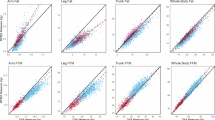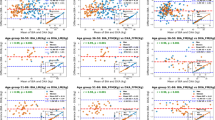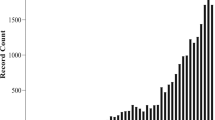Abstract
Background/Objectives:
Extensive work has addressed the validity of bioimpedance (BIA) measurements and the effect of posture on fluid homeostasis. However, limited research has investigated effects of subject preparation. This study aimed to determine the precision of total body water (TBW) and extracellular water (ECW) measurements using a stand-on multifrequency BIA (MFBIA seca mBCA 514/515), in three pre-test procedures: supine, sitting, and following walking, with specific reference to the influence of sex and body mass index (BMI).
Subjects/Methods:
Fifty three healthy, ambulatory men (n=26, age:32.5±9.4 years) and women (n=27, age:35.2±10.3 years) received repeat MFBIA measurements (six measurements from 0 to 15 min). Agreement and precision were evaluated for each condition and paired time points.
Results:
Significant TBW sex differences from supine posture were observed for walking (females) and sitting (males) postures. For BMI (⩽24.9 kg m−2) significant TBW differences from supine were observed for both sitting and walking and significant ECW differences from sitting were also observed with both supine and walking. There was no significant effect of sex or BMI (⩾25.0 kg m−2) on ECW measures. Irrespective of sex or BMI, there was close agreement in TBW and ECW precision over the three protocols.
Conclusions:
Practitioners can have confidence in the precision of TBW and ECW measurements within a 15 min time period and pre-testing conditions (supine, sitting or walking) in healthy subjects, though must be cautious in assessments when pre-test postures change. Further research to examine the impact of pre-testing procedures on stand-on MFBIA BIA measurements, including subjects with fluid disturbance, is warranted.
This is a preview of subscription content, access via your institution
Access options
Subscribe to this journal
Receive 12 print issues and online access
$259.00 per year
only $21.58 per issue
Buy this article
- Purchase on SpringerLink
- Instant access to full article PDF
Prices may be subject to local taxes which are calculated during checkout



Similar content being viewed by others
References
Morgenstern B, Nair K, Lerner G, Neu A, Quarn A, Warady B . Importance of total body water errors on Kt/V estimates in children on peritoneal dialysis. Adv Perit Dialysis 2001; 17: 260–263.
Medici G, Mussi C, Fantuzzi AL, Malavolti M, Albertazzi A, Bedogni G . Accuracy of eight-polar bioelectrical impedance analysis for the assessment of total and appendicular body composition in peritoneal dialysis patients. Eur J Clin Nutr 2005; 59: 932–937.
Woodrow G, Devine Y, Cullen M, Lindley E . Application of bio electrical impedance to clinical assessment of body composition in peritoneal dialysis. Periton Dialys Int 2007; 27: 496–502.
Jacobs DO . Use of bioelectrical impedance measurements in the clinical management of critical illness. Am J Clin Nutr 1996; 64: 4985–50025.
Kushner RF, Schoeller DA, Fjels CR, Danford L . Is the impedance index (Ht2/R) significant in predicting total body water. Am J Clin Nutr 1992 1992; 56: 835–839.
Foster KR, Lukaski HC . Whole body bio impedance - what does it measure? Am J Clin Nutr 1996; 64: 388S–396S.
Moissl UM, Wabel P, Chamney PW, Bosaeus I, Levin NW, Bosy-Westphal A et al. Body fluid volume determination via body composition spectroscopy in health and disease. Physiol Meas 2006; 27: 921–933.
Bosy-Westphal A, Schautz B, Latter W, Kehayias JS, Gallagher D, Muller MJ . What makes a BIA equation unique? Validity of eight electrode multi-frequency BIA to estimate body composition in a healthy adult population. Eur J Clin Nutr 2013; 67: S14–S21.
Peine S, Knabe S, Carrero I, Brundert M, Wilhelm J, Ewert A et al. Generation of normal ranges for measures of body composition in adults based on bioelectrical impedance analysis using the seca mBCA. Int J Body Comp Res 2013; 11: 67–76.
Kushner RF, Gudivaka R, Schoeller DA . Clinical characteristics influencing bioelectrical impedance analysis measurements. Amer J Clin Nutr 1996; 64 (suppl), 423S–427S.
Brantlov S, Ward LC, Jødal L, Rittig S, Lange A . Critical factors and their impact on bioelectrical impedance analysis in children: a review. J Med Eng Technol 2017; 41: 22–35.
Medrano G, Eitner F, Walterr M, Leonhardt S . Model-based correction of the influence of body position on continuous segmental and hand to foot bioimpedance measurements. Med Biol Eng Comput 2010; 48: 531–541.
Scharfetter H, Monif M, Laszlo Z, Lambauer T, Hutten H, Hinghofer-Szalkay H . Effect of postural changes on the reliability of volume estimations from bioimpedance spectroscopy data. Kidney Int 1997; 51: 1078–1087.
Slinde F, Bark A, Jansson J, Rossander-Hulthén L . Bioelectrical impedance variation in healthy subjects during 12h in the supine position. Clinical Nutrition. 2003; 22: 153–157.
Rush EC, Crowley J, Freitas IF, Luke A . Validity of hand‐to‐foot measurement of bioimpedance: standing compared with lying position. Obesity 2006; 14: 252–257.
Gibson AL, Holmes JC . Comparison of body water compartment values from a diverse adult sample using vertical and supine BIS analysers. Int J Body Comp 2011; 9: 101–110.
Kagawa M, Wishart C, Hills AP . Influence of posture and frequency modes in total body water estimation using bioelectrical impedance spectroscopy in boys and adult males. Nutrients 2014; 6: 1886–1898.
Lee LC, Hsieh KC, Wu CS, Chen YJ, Chiang J, Chen YY . Validity of standing posture eight-electrode bioelectrical impedance to estimate body composition in Taiwanese elderly. Int J Gerontol 2014; 8: 137–142.
Gibson AL, Beam JR, Alencar MK, Zuhl MN, Mermier CM . Time course of supine and standing shifts in total body, intracellular and extracellular water for a sample of healthy adults. Eur J Clin Nutr 2015; 69: 14–19.
Oshima Y, Shiga T . Within-day variability of whole-body and segmental bioelectrical impedance in a standing position. Eur J Clin Nutr 2006; 60: 938–941.
Shafer KJ, Siders WA, Johnson LK, Lukaski HC . Validity of segmental multiple-frequency bioelectrical impedance analysis to estimate body composition of adults across a range of body mass indexes. Nutrition 2009; 25: 25–32.
Gába A, Kapuš O, Cuberek R, Botek M . Comparison of multi‐and single‐frequency bioelectrical impedance analysis with dual‐energy X‐ray absorptiometry for assessment of body composition in post‐menopausal women: effects of body mass index and accelerometer‐determined physical activity. J Hum Nutr Dietet 2015; 28: 390–400.
Zhu F, Schneditz D, Wang E, Levin NW . Dynamics of segmental extracellular volumes during changes in body position by bioimpedance analysis. J Appl Physiol 1998; 85: 497–504.
Fenech M, Jaffrin MY . Extracellular volume variations during postural change measured by segmental and wrist-ankle bioimpedance spectroscopy. IEEE Trans Biomed Eng 2004; 51: 155–175.
Raimann JG, Zhu F, Wang J, Thijssen S, Kahlmain M, Katanke P et al. Comparison of fluid volume estimates in chronic hemodialysis subjects by BIA, direct isotopic and dilution methods. Kidney Int 2014; 85: 898–908.
Acknowledgements
SECA provided monetary compensation to subjects for their time participating in the study programme. None of the researchers received direct funding from the company.
Author contributions
KH, BO and ST conception and design of the study; KH, BO, ST and GT-C generation, collection, assembly, analysis and/or interpretation of data; and KH, BO, ST, GT-C and PS drafting or revision of the manuscript and approval of the final version of the manuscript.
Author information
Authors and Affiliations
Corresponding author
Ethics declarations
Competing interests
The authors declare no conflict of interest.
Rights and permissions
About this article
Cite this article
Thurlow, S., Taylor-Covill, G., Sahota, P. et al. Effects of procedure, upright equilibrium time, sex and BMI on the precision of body fluid measurements using bioelectrical impedance analysis. Eur J Clin Nutr 72, 148–153 (2018). https://doi.org/10.1038/ejcn.2017.110
Received:
Revised:
Accepted:
Published:
Issue date:
DOI: https://doi.org/10.1038/ejcn.2017.110
This article is cited by
-
Single-slice CT measurements allow for accurate assessment of sarcopenia and body composition
European Radiology (2020)



